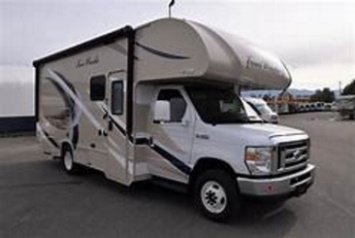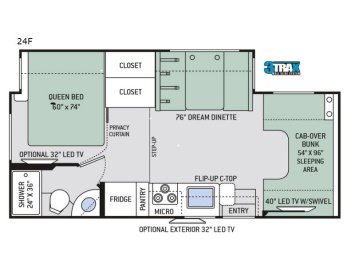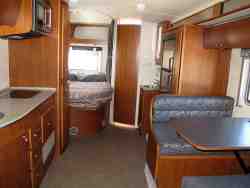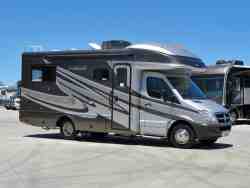[?]Subscribe To This Site
Aftermarket RV Braking Systems
Aftermarket RV braking systems for our motorhomes and dinghies have been on the market for several years. These braking systems came into play because many of us motorhome owners have demonstrated that we understand the need to tow a car safely.

Custom Search
Because of the high demand for a quality product, the RV braking systems' overall design improvements and reliability have improved significantly in recent years.
Essentially, Class C Motorhome owners have invested a lot of dollars into their rigs, and they have a strong interest in protecting their investment from unnecessary risk.
This unnecessary risk can manifest itself in a problem while braking. Our rigs don't like to slow down and stop without taking up a fare amount of real estate. All of this is compounded even more when faced with an emergency.
You know... like those last second light changes that we seem to get caught up in... Or a scenario where we create an emergency situation while coming off a hill and having the weight of a dinghy pushing us along without the additional stopping power of some type of RV braking system.
There are many good systems available for a cost of around $1,000. This cost is justified primarily for the piece of mind it will bring.
that you didn't stop soon enough because your
unbraked dinghy was pushing you.
Essentially, there are two types of RV braking systems available:
- A vacuum a assisted model that requires a certain amount of modification to the dinghy's internal braking system.
- A mechanically assisted model that applies braking pressure directly to the brake peddle without having to modify any of the dinghy's braking system.
Designed RV Braking System?
- As a general rule, you will want to make the least amount of changes to your Class C Motorhome or your dinghy as you possibly can.
- When you start making these modifications, you simply make things less clear, and this could potentially open the door for service manager excuses... I can just see a service manager pointing to the modified hydraulic line, vacuum line, master cylinder, or any other component, and saying, "That’s what caused the problem!".
- Bottom line, the more modifications required the more failure possibilities there are. The fewer the modifications the better it is. This is especially important if you attempt to perform these modifications yourself.
RV braking system... there is no need to mess with or
modify the dinghy's brake system
- It seems that there are no perfect solutions in any type of RV braking system. Even if you choose not to use some type of vacuum assisted braking mechanism and go with a straight mechanical device, you may inadvertently cause problems.
- For anyone who has attempted to stop their vehicle when the engine is not running, it soon becomes apparent that a great amount of force is required. This is because our modern automobiles and trucks have vacuum assisted brakes, steering, etc. When there is no vacuum assist on our cars/trucks things simply become much harder.
- For anyone who has attempted to stop their vehicle when the engine is not running, it soon becomes apparent that a great amount of force is required. This is because our modern automobiles and trucks have vacuum assisted brakes, steering, etc. When there is no vacuum assist on our cars/trucks things simply become much harder.
- Normal vacuum assisted braking only requires around 20 lbs of pressure. However, non-assisted brake pressure (like when the engine is not running) can go as high as 200 to 400 lbs when attempting to stop a dinghy from, let's say 60 mph. That's a lot of pressure that could potentially break the brake pedal mechanism.
Even though you will have to make some modifications to the dinghy brakes, you will not be using brute force to stop your vehicle.
- Assisted braking systems only require around 20 lbs of pressure. Therefore, if you choose one of the RV braking systems that utilizes the charged vacuum assist design that comes integrally with your dinghy, you will be better off... from an applied pedal pressure perspective.
- It is also important for your system to be able to handle an emergancy breakaway... if the dinghy breaks loose from your motorhome at highway speed, there must be enough pedal power to stop it in a reasonable distance.
- It is also important for your system to be able to handle an emergancy breakaway... if the dinghy breaks loose from your motorhome at highway speed, there must be enough pedal power to stop it in a reasonable distance.
vacuum assisted brakes equal a potential warranty issue while non-vacuum assisted brakes equal potential physical harm to your dinghy's mechanical support system.
- There are a few things to go over here:
- A good dinghy braking system can be adjusted in the motorhome so as to better control the sensitivity of response... simply put, you do not want the dinghy brakes coming on prematurely and "riding the brakes", or coming on too late and not give proper assist.
- Riding the brakes can cause premature wear and/or fire. This can happen while descending a mountain grade, backing up, or negotiating speed bumps.
- The best designs can sense a motion differential and match the brake pressure that has been applied to the motorhome service brake.
- Those designs that use some type of delay mechanism to compensate for control issues only delay braking and complicate the issue.
- The best designs can sense a motion differential and match the brake pressure that has been applied to the motorhome service brake.
- A good dinghy braking system can be adjusted in the motorhome so as to better control the sensitivity of response... simply put, you do not want the dinghy brakes coming on prematurely and "riding the brakes", or coming on too late and not give proper assist.
pedal... not before and not afterwords.
- You want a system that will not require constant adjustment after installation. It will, however, require some periodic adjustments as the situation requires. This should be a no-brainer process.
- Your RV braking system should have some type of light and/or sound indicator showing the braking status in the motorhome. The motorhome driver should be able to continually verify the braking operation and not simply assume that it is working as expected. It is an additional advantage to be able to verify this operation while driving solo.
- You will want your dinghy towing brake system to:
- be easy to connect and disconnect.
- be simple to stow
- not require adjustment each time it is used
- be easy to connect and disconnect.
Here is a partial list of manufactures and or retail outlets that offer a selection of RV braking systems. I will add to this list as I find the web sites or phone numbers.
- SMI Stay-IN-Play... http://smibrake.com/stay-in-play-duo.html
- A vacuum assisted unit that has the smallest actuator in the industry... activation of the towed vehicle's brakes require BOTH deceleration and the brake lights from the motorhome.
- A vacuum assisted unit that has the smallest actuator in the industry... activation of the towed vehicle's brakes require BOTH deceleration and the brake lights from the motorhome.
- M&G Car Braking System for RV coaches with HYDRAULIC BRAKES... http://www.m-gengineering.com/
- A vacuum assisted unit that uses a coach mounted "power pack" with a quick disconnect arrangement between the two vehicles.
- A vacuum assisted unit that uses a coach mounted "power pack" with a quick disconnect arrangement between the two vehicles.
- Unified Tow Brake... http://www.usgear.cc/unified_tow_brake.htm
- A vacuum assisted unit that provides both progressive and proportional braking... comes with installation CD video.
- A vacuum assisted unit that provides both progressive and proportional braking... comes with installation CD video.
- RoadMaster/BrakeMaster... Add-a-Brake Portable Supplemental Braking System
- A Direct proportional baking system... not vacuum assisted.
- A Direct proportional baking system... not vacuum assisted.
- BrakeSafe Braking System... http://www.blueox.us/Brakes/brakesafe.htm
- Does not tap into the towed cars braking system.
- Does not tap into the towed cars braking system.
- BrakeBuddy... http://www.brakebuddy.com/Products/BrakeBuddy-Vantage-Select-Boost
- Does not tap into the towed cars braking system... Offers Full Braking or Proportional Braking.
- Does not tap into the towed cars braking system... Offers Full Braking or Proportional Braking.
- MountainMaster Tow Brake... http://www.towbrake.com/mmaster.html
- Does not tap into the towed cars braking system... unit will trickle charge the towed vehicle battery.
Return To Top Of Page
Leave Aftermarket RV Braking Systems And Return To
Motorhome Dinghy Towing
Leave Aftermarket RV Braking Systems And Return To Home Page
Your Stories
Onan AC Generator Wouldn't Start
1995 Tioga Montara Had a Leak - Ouch!
A Simple Way To Put An Elecrtrical Thermostat On A Small Space Heater In A Truck Camper!
A Great Destinaton, With An Unexpected Outcome!

2018 Thor 21F Four Winds Class C Motorhome

2018 Thor 21F Four Winds Class C Motorhome
2010 Fleetwood Pulse 24D
Class C Motorhome

2010 Fleetwood Pulse 24D
Class C Motorhome
Above Graphics Courtesy of:
http://www.DeMartini.com
| Gasoline Prices |






